

The Essence of Connected Learning. Connected Learning: The Power Of Social Learning Models. DML (a “Digital Media and Learning” project), believes in the “the power of participation.”

And they’ve created a learning model overview to prove it. We recently published our Inside-Out Learning model, an attempt to return the learning to the families, organizations, and communities authentic to the learner. DML’s model is similar in philosophy, underscoring the role of interdependence. Educators as Social Networked Learners. This fall, I am getting the opportunity to design and teach a graduate course for Boise State University’s Education Technology Program entitled, Social Networked Learning.

The majority of students in the program are K-12 in-service teachers who are seeking ways to enhance their teaching with integrated and emerging technologies. Educators: Embrace Social Media. What is up with teacher development and the fear of social media?
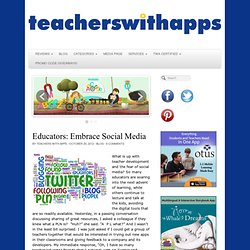
So many educators are soaring into the next advent of learning, while others continue to lecture and talk at the kids, avoiding the digital tools that are so readily available. Yesterday, in a passing conversation discussing sharing of great resources, I asked a colleague if they knew what a PLN is? ”Huh?” She said.
“A P L what?” My world has become immersed in Twitter; I find it to be one of the single most important tools in my own daily professional development. I’d like to mention some of my educationally revered friends and give them a little plug since they have helped me grow. Now, don’t get me wrong… my friends on Twitter are more like colleagues. A Day In The Life Of A Connected Educator. From E-Learning to We-Learning. The corporate training industry is undergoing some major changes.

Over last few months we have been involved in many discussions with organizations about the tremendous needs to build, manage, and formalize their social and collaborative learning programs. This is being driven by many factors: the slowing economy, the "always-connected" nature of the workforce, and the explosion of social software tools and platforms now available. In many ways, this transition is very similar to the last "big thing" to hit corporate training - the "e-learning" era. The word "e-learning" started in 1998 and we went through a radical change in thinking about training over the next 10 years.
¿Por qué es tan importante la #colaboración? ¿Qué es y cómo funciona? Allá por 2008 escribíamos en ergonomic sobre una charla que Andrew Keen daba en el Oxford Internet Institute.

En esos días, Keen ironizaba lo que entonces llamaba: “… las tres “C” que promueve el evangelio de Silicon Valley: colaboración, comunidad y conversación…”. Desde entonces hasta ahora muchos bits han pasado bajo nuestros teclados. Hoy se discute menos sobre Web 2.0, una parte de Internet se ‘salió’ de los navegadores como nos decía Anderson y por sobre todo la fauna de dispositivos digitales se ha multiplicado a una velocidad sorprendente (ver los datos de Internet Telecommunication Union). Sin embargo, aunque mucho ha ocurrido entre el ’08 y ’13 aún queda bastante por explorar y precisar en cuanto a qué entendemos por colaboración, comunidad y conversación.
En conversación con un alumni de Outliers School surgió la idea de pensar en un simple pero inclusivo diagrama cartesiano que interrelacionara las dimensiones de aprendizaje individual, colectivo, formal e informal. 1. 2. 3. Are We in an An Age of Collective Learning? This is a guest post by Rotana Ty from Paris, France, who curates on the subject of “exploring learning” on Permamarks.
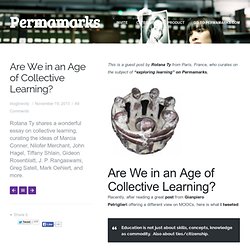
Are We in an Age of Collective Learning? Recently, after reading a great post from Gianpiero Petriglieri offering a different view on MOOCs, here is what I tweeted: Education is not just about skills, concepts, knowledge as commodity. Also about ties/citizenship. Communities of practice. The term “community of practice” is of relatively recent coinage, even though the phenomenon it refers to is age-old.
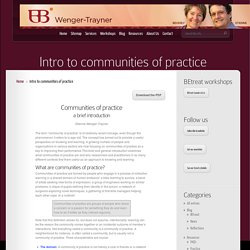
The concept has turned out to provide a useful perspective on knowing and learning. A growing number of people and organizations in various sectors are now focusing on communities of practice as a key to improving their performance.This brief and general introduction examines what communities of practice are and why researchers and practitioners in so many different contexts find them useful as an approach to knowing and learning. What are communities of practice? Note that this definition allows for, but does not assume, intentionality: learning can be the reason the community comes together or an incidental outcome of member’s interactions.
Learning 2.0 is Dumb: Use ‘Connected Learning’ Instead. Going forward, and as best I can, I’ll use the term ‘Connected Learning’ to describe a knowledge ecosystem made up of formal, informal and social learning behaviours and modalities.
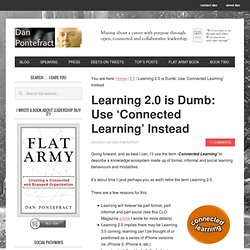
It’s about time I (and perhaps you as well) retire the term Learning 2.0. There are a few reasons for this: Therefore, I present to you ‘Connected Learning’ … at least from a modality perspective: If ‘Connected Learning’ is part formal, part informal and part social, there will always be the act of ‘connecting’ one’s self to people, content, systems, networks, etc. during the learning process itself … and it may occur through several mediums. Formal: a self-contained & scheduled learning event, typically but not always tracked, providing a comprehensive and at times logical or sequential approach to a topic. Informal: an opportunity without conventionalism, atypical to formal learning, providing guidance, expertise or acumen on the go. Connectivism. Educational Technology and Mobile Learning: Connected Learning Explained. Are we really taking advantage of this digital information age to enhance the quality of today's education?
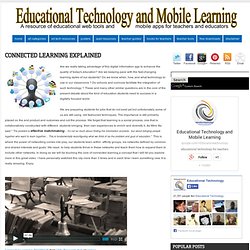
Are we keeping pace with the fast-changing learning styles of our students? Do we know when, how, and what technology to use in our classrooms ? Do schools and curricula facilitate the integration of such technology ? These and many other similar questions are in the core of the present debate about the kind of education students need to success in a digitally focused world. We are preparing students for jobs that do not exist yet but unfortunately some of us are still using old fashioned techniques.
ConnectedLearning_report.pdf.